Sweeping vistas, legroom and bar trolleys - Consider the train next time you travel in Spain
Thursday, June 30, 2016
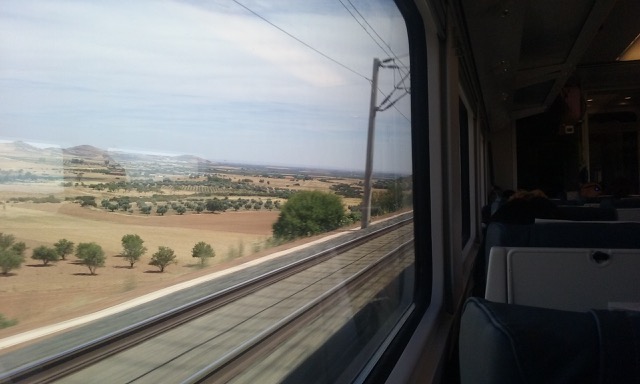
Last week, I was a substitute for an English teacher in town. Summer being here and exams over, I asked the giggly teenagers about their preferred mode of travel. They all answered Planes, even a student who had never been on one. “What about trains?” I asked, receiving eye-rolls all around. Trains are for old people, like grandparents and such, they informed me. Obviously, I must be getting old, because for me there is no equivalent to the railways. There is something very soothing about sitting on a train and letting oneself be tuff-tuff-ed along without worries or responsibilities. As long as there are tracks to the destination and time and money to spare, I will choose the railway every time.
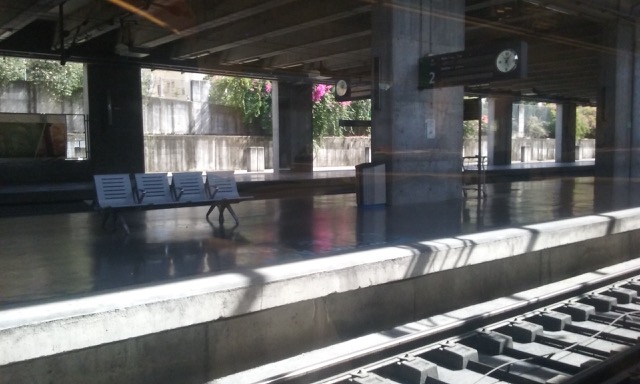
Unless one is in a desperate time crunch, why would anyone choose to fly within Spain? Take the check-in. One must be at the airport at least an hour before a flight, while you can roll in just minutes before your departure to catch a train. With trains, there are no worries of overweight, having too many pieces of luggage, as long as you can manage to drag your suitcases along. You can bring along a bottle or two of preferred choice of fluids, a basket of fresh fruit and an entire beauty bag of full-sized perfumes, cremes and lotions. Once onboard, one will rarely be asked to show ones tickets. In fact, on a recent journey to the capital, we did not see a single official representative on the train, other than the one bringing the bar trolley along at steady refill intervals. Train travel does not involve removing belts, jewellery, shoes and what have you. You will not be frisked nor be forced to go through the all-revealing, full-figure, hands-up, circular scanning chamber. In short, you can still enter a Spanish train with your self-respect and outfit intact!
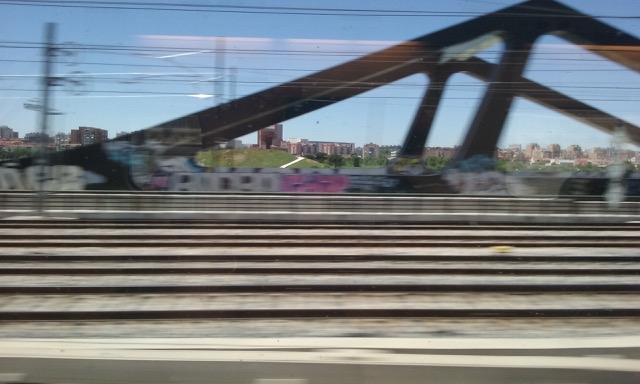
Time-wise, trains are admittedly slower than flying. However, with Spain’s AVE trains average running speed of 150 - 200 km/h (they can go up to about 350), we can get from Ronda to Madrid in four hours and to Barcelona in just over eight. Calculating the drive to the airport, the additional time required for check-in, the waiting at the tarmac, the slow loading and off-loading, the endless airport corridors, the wait for the suitcases and the bottleneck at the final security exit, there are actually few minutes to be saved by taking a national flight in Spain. Added to this is the fact that most major airports are located far outside the big cities to whom they pertain, while train stations are usually located smack in the centre of the city, usually making it a shorter cab-ride to ones final destination. There is clearly time and money to be saved on international air travel, but for in-nation trips trains are quite competitive. Those who have entered the Golden Age can apply for La Tarjeta Dorada, which for merely 6 euro per annum gives generous senior discounts. I am not there yet, but there is always something to look forward to when one does cross that milepost…

Comparing fuel costs to train tickets, it is cheaper to drive than take the train, certainly if you are a family or a group of friends. But this means that at least one of you have to be the designated driver, needing to worry about traffic police and watching out for head-on collisions. Then there are speed traps, carsickness, roadblocks, accidents and construction, taking the wrong turnoff and trying to get back on the Autovía without a 10 km detour, unexplainable bumper-to-bumper delays on the highway, the we-need-to-stop-at-the-next-washroom conundrum, running out of fuel, the driver falling asleep at the wheel, or untimely engine trouble. Finally, there is the question of how to ‘get rid off’ the car or where to park when you arrive at the destination. On a train, everyone gets to enjoy the view and can have a glass of wine with lunch. Indeed, it is the ultimate democratic mode of travel.
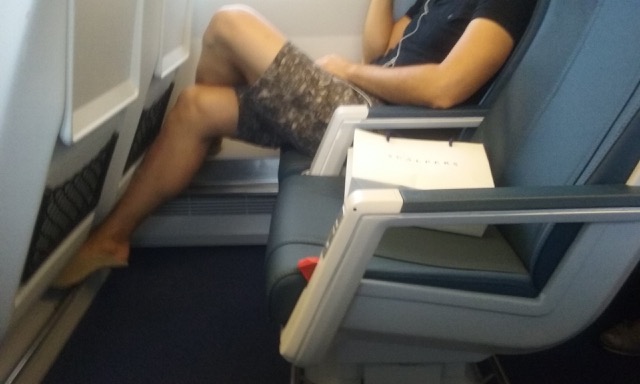
In my experience, the Spanish trains are generally comfortable, spacious and clean. On longer train rides, seats are assigned, while local trains have free seating. Luggage is stored at the end of the carriages, or in the open hat shelf above, which fits even the most overstuffed Japanese suitcase. Compared to airplanes, train seats are wider, cushier, and lastly something quite vital, there is ample legroom for even the lankiest teenager to kick of their alpargatas. There are no compulsory security announcements, blinking seat belts signs, air-masks above, nor flotation devices beneath one’s seat. The train windows offer wide panoramic views on both sides, as opposed to an airplane’s tiny portholes. One can walk freely about on trains, enter the washrooms at any time, or spend basically the entire ride in one of the train’s bar carriages, which have a better menu than most flights I have been on. If you do not wish to move, the food trolley will come to you. And even the coffee is decent! Like most airlines, you are offered headphones and free films on Spanish long-distance trains. There is no entertainment choice, and it is usually a dubbed, American B movie, a Spanish sitcom or a cartoon to keep the kids quiet (There are adult-only train cabins, though I am yet to verify if the films are ‘adult’, as well.) But with the stunning Spanish landscape passing by, a café con leche or a tinto and a good book in hand, who needs movies?
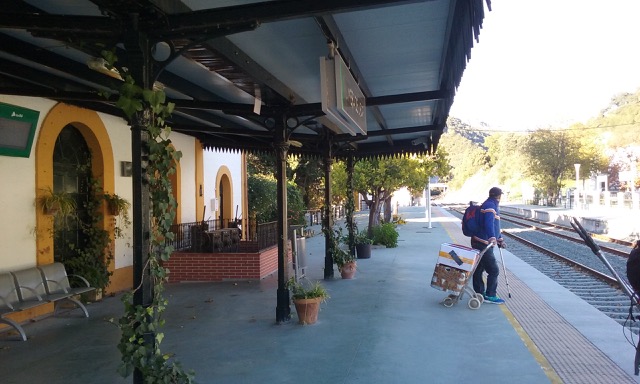
Local Spanish trains chug along at a more leisurely speed and may be a bit worn at the edges, but they generally run on time and get one to ones destination in safety and comfort. There are countless Andalucian villages, many that time seem to have forgotten, with charming stations, some even still receiving trains. Take the station in Jimera de Libar. Though the village only has 450 aging residents, it is a regular stop on the Algeciras train route. Here, the stationmaster will still come out in his classic conductor cap to wave a red flag and blow his whistle. Whether he or his kin are responsible for the upkeep of the station, they should receive the award of the year for the station with the most character. All along the platform and on the station house there are floor to ceiling creepers, hanging potted plants, old lanterns and a couple of shrines to some virgin or another. In spring, the orange groves and lemon trees nearby makes one feel that one has come to an olfactory heaven. There are benches to sit on and shade to be had for all.
Should you have an hour to spare before your train departs, across the rails a few hundred meters along is the local pub where the English/Danish hosts make their own brew and serve curry, bratwurst and even Mexican fare. It is such a welcoming place that you might be tempted to miss your train. So hurry up slowly, as there are only four trains per day and yours is likely to be the last one…
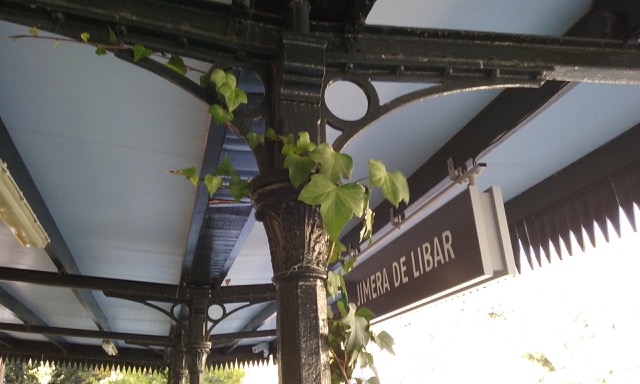
 1
Like
Published at 4:42 PM Comments (6)
1
Like
Published at 4:42 PM Comments (6)
Mother Superior’s Mini Storage and Other Nun’s Tales
Tuesday, June 21, 2016

In North America, nuns are usually a thing one only sees in the movies or during Halloween, which is why I keep expecting the nuns we pass in our hometown Ronda to break into a Monte Python song and dance routine. But of course, they never do. They are actually real nuns.
One may be right to think that the Catholic church changes at a sub-glacial speed, but when it comes to women of the habit, their life have changed dramatically in the last couple of generations. Take Ronda. There are still seven convents in operation here, but just like most places in the world, the numbers of nuns have declined significantly. Our local ‘nunnery’ has seven nuns, compared to the twenty-four nuns who lived there just a few decades ago. The demographics have changed as well, with the average age of the nuns now seemingly well over 70. The younger nuns inevitably are ‘imported’ from Africa, Asia, or ‘the Americas’, like our friend, sister Clara.

Sor Clara was a teacher in Mexico in her former life and finally took her nun’s wows only a couple of weeks ago, after being a novice for some three years. She is young, bright and ever so friendly. From what I understood, and of course I may be very wrong, she found her space at the convent through the Internet.
As their numbers decline, our local nuns have had to adapt. Though the order is cloistered, these days they go outside to visit doctors, buy necessary goods and to deal with government offices. To Mother Superior's dread, some of the nuns now even have cell phones. We met Sor Clara one day on the street carrying musical notes. She explained that the nun who used to accompany their mass is getting too old, so she is taking classes to be able to fulfill this task. Somehow our conversation turned to food (a favourite topic of conversation for the Spanish…) and my Mexican-born husband offered to make Sor Clara some chicken with mole sauce from their native land. Clara was ever so excited. However, she said, it would have to be this coming week, because she was going back to Mexico for her vacation in August, a perk she had never expected when she came to teh convent. I do not know if holidays are an exclusive right for Franciscan nuns, or maybe just a special arrangement for nuns in leisure-loving Spain? Or could it possibly be part of a new universal Catholic nun’s employment plan? Regardless, times have indeed changed when cloistered nuns have vacations…
 The roles they play in society have also changed. Gone are the days when nuns and monks were responsible for virtually all education in Spain. Equally, it is at least a generation or two since people here would call on a Hermano or Hermana to heal an ailing relative. Though some nuns in Ronda still teach school children, there are now few government-approved and certified educators or legally qualified health practitioners amongst these ladies of the cloth. Just a generation back, cloistered nuns would grow most of their food and literally never be seen outside the cloister walls. They would refuse to see doctors, because they were supposed to take care of their own – and God would see to the rest. Today, the nuns of our barrio have annual medical checkups and receive outside care when needed. Ironically, last time they had their checkup, the only nun passing the test with flying colours was the ancient, tiny and ever-smiling Mother Superior, who makes my 85-year-old mom look like a youngster… The roles they play in society have also changed. Gone are the days when nuns and monks were responsible for virtually all education in Spain. Equally, it is at least a generation or two since people here would call on a Hermano or Hermana to heal an ailing relative. Though some nuns in Ronda still teach school children, there are now few government-approved and certified educators or legally qualified health practitioners amongst these ladies of the cloth. Just a generation back, cloistered nuns would grow most of their food and literally never be seen outside the cloister walls. They would refuse to see doctors, because they were supposed to take care of their own – and God would see to the rest. Today, the nuns of our barrio have annual medical checkups and receive outside care when needed. Ironically, last time they had their checkup, the only nun passing the test with flying colours was the ancient, tiny and ever-smiling Mother Superior, who makes my 85-year-old mom look like a youngster…
 Of course with no more teaching or healing to tend to, the nuns have to think of new ways to bring in funds to keep up their benevolent work. We knew that our convent, like others in town, still make and sell baked goods to have a bit of cash flow, but we had no idea what their other business ventures entailed – until one day we decided to move… Of course with no more teaching or healing to tend to, the nuns have to think of new ways to bring in funds to keep up their benevolent work. We knew that our convent, like others in town, still make and sell baked goods to have a bit of cash flow, but we had no idea what their other business ventures entailed – until one day we decided to move…
My husband and I had spent two winters in a cold and drafty flat in Ronda and finally decided to move into a smaller, warmer place before the summer turned to fall. People usually associate Spain with heat and though our summers see temperatures above 40*C, our winters can be very cold. For this reason, traditional Andalucían houses were built with thick stone walls and with small window and door openings. Unfortunately, many ‘modern’ buildings skimp on isolation, combine paper-thin walls with large window panes, without double of triple glazing to isolate against temperature dips and loud parties.
Looking for a place to rent in Ronda was easy, in contrast to when we originally got here. We sent out a ‘What’s App’ message to a few friends and neighbours and were offered the future retirement flat of friends of friends. It was perfect and had doors and windows that actually closed, so we wouldn't be heating for the crows in the winter. We asked our landlady if they had a storage for the 56 boxes of books and art that we brought from Canada. “Ask the nuns’ she said, as obviously everybody in our neigbourhood except us knew that the nuns rented out storage space.
 We went directly to the convent down the street, ringing the bell at the gate. From the not entirely state-of-the-art intercom system came an “Ave María Purísima” in a quivery old voice. My husband who thankfully was an altar boy in his youth answered ”Sin pecado concebida” and magically, things started happening on the inside. Amazing what can be achieved when one knows ones prayers… Two nuns, one tiny and old, the other more robust and double chinned (both perfect cast for “The Sound of Music”) came to the gate. Still wanting to assure that we were of pure intent, they inquired about our errand from behind the locked gate. Once it was established that my husband was Mexican and even knew Aguascalientes, where Sor Clara came from, we were not only let in the gate, but into the convent. Like long-lost relatives, we were kissed on both cheeks and lead to an inner sanctium and up to the second floor, while the nuns chatted happily on. We went directly to the convent down the street, ringing the bell at the gate. From the not entirely state-of-the-art intercom system came an “Ave María Purísima” in a quivery old voice. My husband who thankfully was an altar boy in his youth answered ”Sin pecado concebida” and magically, things started happening on the inside. Amazing what can be achieved when one knows ones prayers… Two nuns, one tiny and old, the other more robust and double chinned (both perfect cast for “The Sound of Music”) came to the gate. Still wanting to assure that we were of pure intent, they inquired about our errand from behind the locked gate. Once it was established that my husband was Mexican and even knew Aguascalientes, where Sor Clara came from, we were not only let in the gate, but into the convent. Like long-lost relatives, we were kissed on both cheeks and lead to an inner sanctium and up to the second floor, while the nuns chatted happily on.
 Where did one store things in a convent, we wondered? I imagined that we would rent one of the spare nun’s cell and that other unused cells where rented out as similar storage. Though this may be an excellent future business idea for the nuns, I was wrong, Instead, they took us to a large room on the upper floor, with food donations for the poor in one corner, beds and matrasses for single moms and other needy against another wall, broken furniture on the third and a spare corner in between that we could use. The rent was very reasonable, but that was not teh deciding facor, but their smiling faces, happy to help and frankly, to have visitors to chat with, and for the experience in itself, it was truly priceless. Where did one store things in a convent, we wondered? I imagined that we would rent one of the spare nun’s cell and that other unused cells where rented out as similar storage. Though this may be an excellent future business idea for the nuns, I was wrong, Instead, they took us to a large room on the upper floor, with food donations for the poor in one corner, beds and matrasses for single moms and other needy against another wall, broken furniture on the third and a spare corner in between that we could use. The rent was very reasonable, but that was not teh deciding facor, but their smiling faces, happy to help and frankly, to have visitors to chat with, and for the experience in itself, it was truly priceless.
I mean, who else would have gotten to keep their stuff in Mother Superior’s Mini Storage?

 2
Like
Published at 9:40 PM Comments (0)
2
Like
Published at 9:40 PM Comments (0)
The directionally challenged co-pilot’s guide to road-tripping in Andalucía
Friday, June 17, 2016

“Are you a good or a bad co-pilot?” was the topic of discussion on Radio Andalucía a while back. I certainly belong to the latter group, having often led my husband astray, sending him left instead of right at some vital road crossing. Indeed, one could say that I am the co-pilot from hell, though I am exceedingly good at distracting the driver by pointing out places of interest, be it a flowering poppy field, colourful laundry hanging from a fifth floor balcony or a cloud formation looking like a loop-sided piglet.
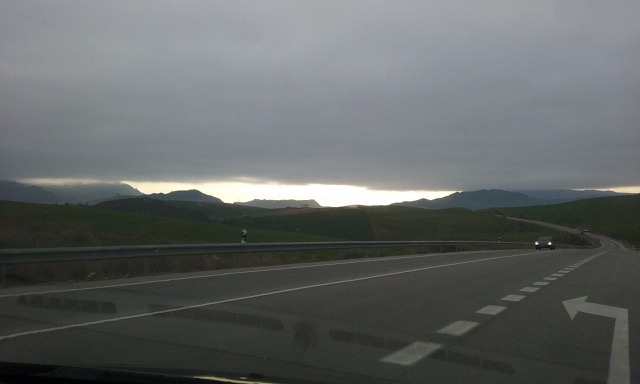 I have come to the acceptance that I am directionally challenged. This tendency to mix up directions actually has a clinical name. It is called Directional Dyslexia or sometimes Spatial or Geographical Dyslexia. Though not an actual kind of dyslexia, the ‘condition’ is distinguished by right/left confusion, or what my husband would call right/the-other-right confusion, often combined with a tendency to become disoriented or lost. Now, I am not such an extreme case, as I only get lost when I choose to. However, given certain circumstances, lets say if someone was to put a gun to my head and say, “March right!” I would inevitably turn left. Or to ‘the other right’… I have come to the acceptance that I am directionally challenged. This tendency to mix up directions actually has a clinical name. It is called Directional Dyslexia or sometimes Spatial or Geographical Dyslexia. Though not an actual kind of dyslexia, the ‘condition’ is distinguished by right/left confusion, or what my husband would call right/the-other-right confusion, often combined with a tendency to become disoriented or lost. Now, I am not such an extreme case, as I only get lost when I choose to. However, given certain circumstances, lets say if someone was to put a gun to my head and say, “March right!” I would inevitably turn left. Or to ‘the other right’…
To my great relief, the Andalucian countryside consists mostly of single-lane roads with endless landmarks, so we, the directionally challenged co-pilots or hereafter DCCPs for short, can say ‘Turn in there after the old farm” or “We are taking off here after that nice big crocked olive tree”, thus cleverly omitting the right/left confusion. However there are times when these tactics wont do, particularly when entering the province’s larger cities, such as Sevilla, Granada or Malaga. With increased traffic there are of course more frequent crossings and turnoffs, thus increasing the need for more rapid direction giving and hence decision-making for the co-pilot. Combine this with the Spanish cutthroat drivers and the DCCPs will have a real challenge on their hands.
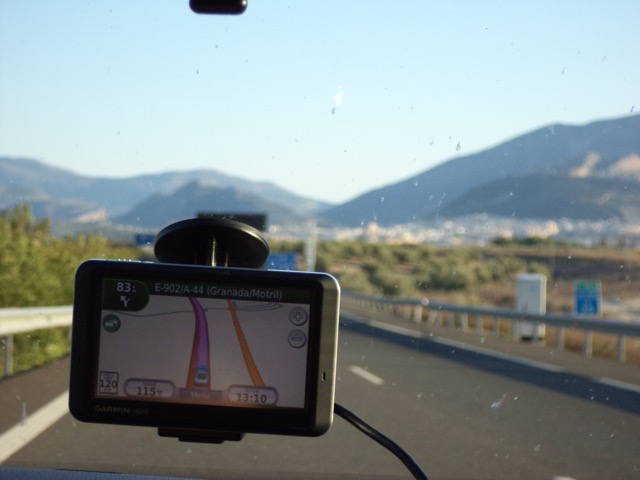 The invention of the GPS has helped us GCCPs significantly, especially the later models, with split screen information and multiple warnings. But right is still right and left is still left and NOT ‘the other right’. If someone, that someone usually being my husband, suddenly calls out to me “Do I go right or left???” I will unfortunately not be able to give an instant answer, and certainly not guaranteed the correct one, particularly not if I have been chatting away or had my eyes on a bicycle with a lovely basket at the front, as who would not be distracted by such? The invention of the GPS has helped us GCCPs significantly, especially the later models, with split screen information and multiple warnings. But right is still right and left is still left and NOT ‘the other right’. If someone, that someone usually being my husband, suddenly calls out to me “Do I go right or left???” I will unfortunately not be able to give an instant answer, and certainly not guaranteed the correct one, particularly not if I have been chatting away or had my eyes on a bicycle with a lovely basket at the front, as who would not be distracted by such?
For many of us GCCPs, the Spanish love for roundabouts can be a saving grace. Glorietas may be a pain in the neck and a magnet for accidents, especially since Spanish drivers rarely use their turn signals and will cut over two lanes of traffic to exit right in front of you without a shudder or an inkling or a ‘sorry’. However, for myself, representing the vast and barely recognized group of GCCPs, there is a trick to be taught. When in doubt, I have learned to say, “Lets go around another time to be sure, shall we?”
 I used to disagree a lot with our old GPS. Initially, we called her la tia (Spanish for aunt), but gradually she became Latifah, after the Queen. I find it much easier to relate to objects when they have a name, and for technical aids like a GPS it feels better to have a name to disagree with. Latifah was imported from Canada and had a dismal Spanish accent. She also had an annoying way of repeating “Recalculating. Recalculating” with a nasal voice whenever I had led us astray, which in the first few months were often, if not always. Thankfully, our new Latifah is much better and do not say anything when I get things wrong. She just quietly finds us another way. Of course, I still manage to get us lost. The other day we were driving back from Sevilla and Latifah had dutifully advised us of the Ronda take off miles ahead of time. I could see from the GPS screen which lane we had to follow, to the right, I mean the real right. Yet, just as we came upon the fork in the row, I called “Go Left” to my husband, while pointing to the right. Thankfully he didn’t crash into the centre island, but took the right turn, justifiably lecturing me of the dangers of having a co-pilot that does not pay attention on the road. It wasn’t that I hadn’t paid any attention. I had actually been staring at Latifah and seen our take off to the right, only in my mind it was left. I used to disagree a lot with our old GPS. Initially, we called her la tia (Spanish for aunt), but gradually she became Latifah, after the Queen. I find it much easier to relate to objects when they have a name, and for technical aids like a GPS it feels better to have a name to disagree with. Latifah was imported from Canada and had a dismal Spanish accent. She also had an annoying way of repeating “Recalculating. Recalculating” with a nasal voice whenever I had led us astray, which in the first few months were often, if not always. Thankfully, our new Latifah is much better and do not say anything when I get things wrong. She just quietly finds us another way. Of course, I still manage to get us lost. The other day we were driving back from Sevilla and Latifah had dutifully advised us of the Ronda take off miles ahead of time. I could see from the GPS screen which lane we had to follow, to the right, I mean the real right. Yet, just as we came upon the fork in the row, I called “Go Left” to my husband, while pointing to the right. Thankfully he didn’t crash into the centre island, but took the right turn, justifiably lecturing me of the dangers of having a co-pilot that does not pay attention on the road. It wasn’t that I hadn’t paid any attention. I had actually been staring at Latifah and seen our take off to the right, only in my mind it was left.
The only viable way of avoiding that GSSPs confuse GPS directions is to create a GPS that uses the expression ‘the-other-right’ instead of left. We, the GPSSs are here to stay, as pilots and co-pilots on the road. We do not cause intentional confusion; we just have a different way of understanding directions. Personally, it is more a question of distraction than disorientation. I simply favour noticing Medieval towers to looking for road signs. This may lead to, and has led to slight discrepancies with above-mentioned husband and with our most trusted Latifah. Yet even they will have to admit that we have discovered many an interesting place through unwillingly or unknowingly taking the wrong turn.
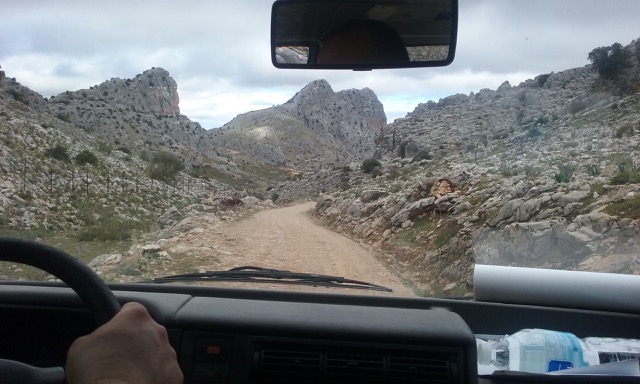
 2
Like
Published at 10:59 AM Comments (2)
2
Like
Published at 10:59 AM Comments (2)
Spam post or Abuse? Please let us know
|
|